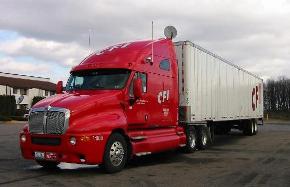An Intro To Big Trucks And Truck Driving School Part III - The CDL Exam
-
Blogs By Author
-
Blogs By Tag

So – back to getting the CDL. First you study the state CDL guide and at the department of licensing (DOL) take the tests for the ratings that you want. Combination vehicle, tanker, bus, triples, hazardous materials, air-brakes, etc. The DOL will also set you up with a CDL learner's permit that allows you to drive with an experienced CDL driver in the other seat. Along the way, you go to your doctor and get a DOT physical. At last, you are ready to go to trucking school. At the school we had a combination of class time, lab time, driving time, and observation time. Weekly tests let us know how we were doing.
Interestingly enough, the biggest cause for test failures is the pre-trip inspection of the truck which you perform each day to know that the truck is safe and ready to go. So a significant amount of time is spent in school discussing and learning the proper way to do this inspection. Other time is spent practicing driving in various conditions – town, freeway, backing etc, and trying to figure out how to smoothly shift. This is one of the toughest parts (for me anyway), and even the pro's sometimes run into a bad shift. Time is spent talking about securing loads, installing chains, theory of air-brake systems, using log-books, load distribution, how to deal with weigh stations, and so on.
Taking The CDL Exam
Finally, after logging the 160 hours (or more), it's time to take the test. The testing person was a third-party contractor certified by, and hired by the state. I was as nervous as I was forty-five years ago when I took my original driver's license test. The test entails three parts:
Pre-trip inspection:
Here you need to go through a very complete and detailed check of the truck for safety. It starts with the tests for the air brakes, which involves a number of steps, if you miss any of them, your test is over right away. Then during a walk-around of the vehicle, you check integrity of steering, suspension, wheels and tires, fluid-levels, frame, air and electrical lines, etc. Essentially, it's necessary to memorize the state CDL procedure for this part of the test, and as I mentioned, it's the part of the test causing most failures.
Skills test:
This part of the test demonstrates that you can handle your semi in a loading dock situation. The first part is to back the truck and trailer straight back into a 100' long alley that is 12' wide.The alley is created with cones, but you have to ensure that you don't hit any, and even that the mirrors don't go over top of the cones. At the rear of the alley, you need to stop with the back of the trailer in a 2' long area. Points are deducted of you hit any cones, or need to stop and go forward. And if you forget to check mirrors, beep your horn and turn on flashers before you start backing. I got dinged for forgetting the 4-way flashers. The next part of the test is to pull out of the alley at a 45 degree angle, and then negotiate the truck back into the aisle from this angle. It isn't necessary to go all the way back, the stop-cone zone is further forward during this part of the test.
Road test:
On the road test, you are evaluated as you drive in city, freeway, and side-road conditions. Part of the test involves stopping the rig half-way up a hill, parking it within 12" of the curb, then entering traffic again as you take off up the hill safely and without rolling back. The tester is looking for driving errors such as not checking mirrors, driving over curbs (immediate disqualification), properly negotiating rail road tracks, proper shifting and braking, etc.
Once you pass these tests, you can be issued your CDL for the class truck you have driven and with the endorsements for which you have taken the written tests. Evidently, soon there will be a CDL differentiation for manual vs. automatic transmission. You will need a separate endorsement if you want to be certified for driving a manual transmission.
Thoughts after earning the CDL
When I first found out that the CDL school was required, I thought that it was just another unnecessary state requirement. But after taking the training, I think it was extremely valuable, and a very good idea that it's a requirement. Makes me safer, and also the other people on the road. When I think of all the people out there driving around with motor homes and large trailers, it makes me think that some sort of abbreviated training for those vehicles would be a good idea too. After all, we require special training for motorcycles, yet they seldom do damage to others - driving heavy-weight machines around has a lot of damage potential to others.
After I got my truck, even though it was for personal use, I discovered that I couldn't license it unless I applied for a USDOT number. This requires that you have a sign on the side of your truck with your (or your company) name, home town, and USDOT number. Driving around with your name in big letters on the door makes you a more polite driver. If everybody had to do that, we'd probably have a little less road-rage.
Related Articles:







 TT On Facebook
TT On Facebook